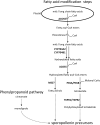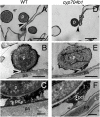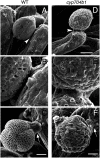Fertile Arabidopsis cyp704b1 mutant, defective in sporopollenin biosynthesis, has a normal pollen coat and lipidic organelles in the tapetum
- PMID: 34177330
- PMCID: PMC8215455
- DOI: 10.5511/plantbiotechnology.20.1214b
Fertile Arabidopsis cyp704b1 mutant, defective in sporopollenin biosynthesis, has a normal pollen coat and lipidic organelles in the tapetum
Abstract
The exine acts as a protectant of the pollen from environmental stresses, and the pollen coat plays an important role in the attachment and recognition of the pollen to the stigma. The pollen coat is made of lipidic organelles in the tapetum. The pollen coat is necessary for fertility, as pollen coat-less mutants, such as those deficient in sterol biosynthesis, show severe male sterility. In contrast, the exine is made of sporopollenin precursors that are biosynthesized in the tapetum. Some mutants involved in sporopollenin biosynthesis lose the exine but show the fertile phenotype. One of these mutants, cyp704b1, was reported to lose not only the exine but also the pollen coat. To identify the cause of the fertile phenotype of the cyp704b1 mutant, the detailed structures of the tapetum tissue and pollen surface in the mutant were analyzed. As a result, the cyp704b1 mutant completely lost the normal exine but had high-electron-density granules localized where the exine should be present. Furthermore, normal lipidic organelles in the tapetum and pollen coat embedded between high-electron-density granules on the pollen surface were observed, unlike in a previous report, and the pollen coat was attached to the stigma. Therefore, the pollen coat is necessary for fertility, and the structure that functions like the exine, such as high-electron-density granules, on the pollen surface may play important roles in retaining the pollen coat in the cyp704b1 mutant.
Keywords: exine; pollen coat; sporopollenin; tapetum.
© 2021 Japanese Society for Plant Biotechnology.
Figures






Similar articles
-
ATP-binding cassette transporter G26 is required for male fertility and pollen exine formation in Arabidopsis.Plant Physiol. 2010 Oct;154(2):678-90. doi: 10.1104/pp.110.161968. Epub 2010 Aug 23. Plant Physiol. 2010. PMID: 20732973 Free PMC article.
-
CYP704B1 is a long-chain fatty acid omega-hydroxylase essential for sporopollenin synthesis in pollen of Arabidopsis.Plant Physiol. 2009 Oct;151(2):574-89. doi: 10.1104/pp.109.144469. Epub 2009 Aug 21. Plant Physiol. 2009. PMID: 19700560 Free PMC article.
-
An ABCG/WBC-type ABC transporter is essential for transport of sporopollenin precursors for exine formation in developing pollen.Plant J. 2011 Jan;65(2):181-93. doi: 10.1111/j.1365-313X.2010.04412.x. Epub 2010 Dec 1. Plant J. 2011. PMID: 21223384
-
Rice anther tapetum: a vital reproductive cell layer for sporopollenin biosynthesis and pollen exine patterning.Plant Biol (Stuttg). 2023 Mar;25(2):233-245. doi: 10.1111/plb.13485. Epub 2022 Dec 16. Plant Biol (Stuttg). 2023. PMID: 36350096 Review.
-
Role of Lipid Metabolism in Plant Pollen Exine Development.Subcell Biochem. 2016;86:315-37. doi: 10.1007/978-3-319-25979-6_13. Subcell Biochem. 2016. PMID: 27023241 Review.
Cited by
-
From the Editors.Plant Biotechnol (Tokyo). 2022 Mar 25;39(1):i-iii. doi: 10.5511/plantbiotechnology.22.editorial. Plant Biotechnol (Tokyo). 2022. PMID: 35800964 Free PMC article. No abstract available.
-
The dynamic regulatory network of stamens and pistils in papaya.BMC Plant Biol. 2025 Feb 25;25(1):254. doi: 10.1186/s12870-025-06242-1. BMC Plant Biol. 2025. PMID: 39994552 Free PMC article.
-
Transcriptome profiling of flower buds of male-sterile lines provides new insights into male sterility mechanism in alfalfa.BMC Plant Biol. 2022 Apr 15;22(1):199. doi: 10.1186/s12870-022-03581-1. BMC Plant Biol. 2022. PMID: 35428186 Free PMC article.
-
Defect in BrMS1, a PHD-finger transcription factor, induces male sterility in ethyl methane sulfonate-mutagenized Chinese cabbage (Brassica rapa L. ssp. pekinensis).Front Plant Sci. 2022 Aug 18;13:992391. doi: 10.3389/fpls.2022.992391. eCollection 2022. Front Plant Sci. 2022. PMID: 36061794 Free PMC article.
-
Identification and Characterization of a Male Sterile Rapeseed (Brassica napus) Line for Hybrid Seed Production.Plants (Basel). 2025 May 6;14(9):1397. doi: 10.3390/plants14091397. Plants (Basel). 2025. PMID: 40364426 Free PMC article.
References
-
- Aarts MGM, Hodge R, Kalantidis K, Florack D, Wilson ZA, Mulligan BJ, Stiekema WJ, Scott R, Pereira A (1997) The Arabidopsis MALE STERILITY 2 protein shares similarity with reductases in elongation/condensation complexes. Plant J 12: 615–623 - PubMed
-
- Ariizumi T, Hatakeyama K, Hinata K, Inatsugi R, Nishida I, Sato S, Kato T, Tabata S, Toriyama K (2004) Disruption of the novel plant protein NEF1 affects lipid accumulation in the plastids of the tapetum and exine formation of pollen, resulting in male sterility in Arabidopsis thaliana. Plant J 39: 170–181 - PubMed
-
- Ariizumi T, Kawanabe T, Hatakeyama K, Sato S, Kato T, Tabata S, Toriyama K (2008) Ultrastructural characterization of exine development of the transient defective exine 1 mutant suggests the existence of a factor involved in constructing reticulate exine architecture from sporopollenin aggregates. Plant Cell Physiol 49: 58–67 - PubMed
LinkOut - more resources
Full Text Sources
Molecular Biology Databases
Research Materials
